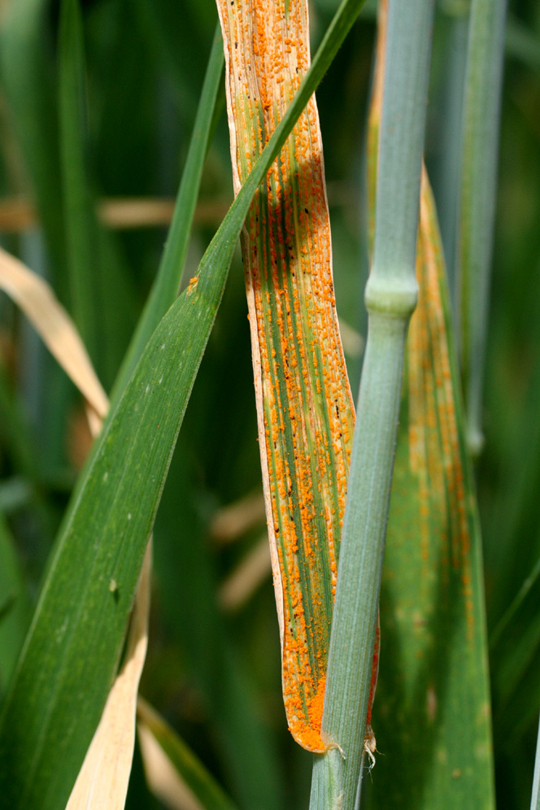
Introduction
Stripe rust (Puccinia striiformis f. sp. tritici) is an important disease of wheat (Triticum aestivum L.), especially in cool climates. Evidence of increased aggressiveness of the disease in the United States has been reported recently. Stripe rust is an emerging disease in the state of Georgia and has been more prevalent in the southern part of the state since 2003.
Rusts are the most economically important group of wheat diseases. More than $5 billion is lost to cereal rusts (leaf rust, stem rust and stripe rust) worldwide each year. The capacity of rusts to develop into widespread epidemics is well documented. Rusts have complex life cycles that involve alternate hosts and several spores stages. Adding to this complexity are the numerous “physiological races” separable by patterns of pathogenicity and virulence on differential hosts. New races continually surface due to the rusts’ ability to mutate and sexually recombine.
Pathogen and Hosts
Stripe rust of wheat is caused by the basidiomycete fungus Puccinia striiformis Westend f. sp. tritici Eriks & Henn (Syn. P. glumarum Erik. and Henn.) in the order Uredinales. It is considered to be an obligate parasite. The fungus produces bright yellow to orange urediniospores 20 to 30 µm in diameter (Figure 1). These spores have thick and echinulated walls and are contained in sori or pustules on the plant (Figure 2). Urenidiospore production usually is followed by teliospore production late in the growing season. No alternate host is known. The pathogen survives in wheat as dormant mycelium in cooler climates.
Early season infections in the southeast are thought to be initiated by spores carried on wind currents from the south-central U.S. and Mexico. P. striiformis f. sp tritici primarily attacks wheat. A separate formae specialis (P. s. f. sp. hordei) attacks barley. Puccinia striiformis f. sp. tritici has numerous physiological races.
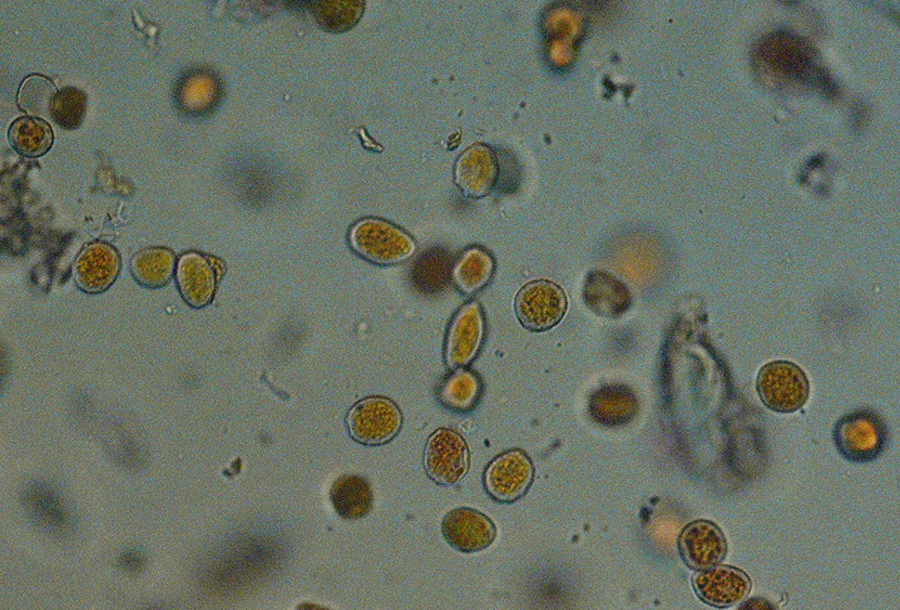 Figure 1a. Urediniospores of P. striiformis = 10x
Figure 1a. Urediniospores of P. striiformis = 10x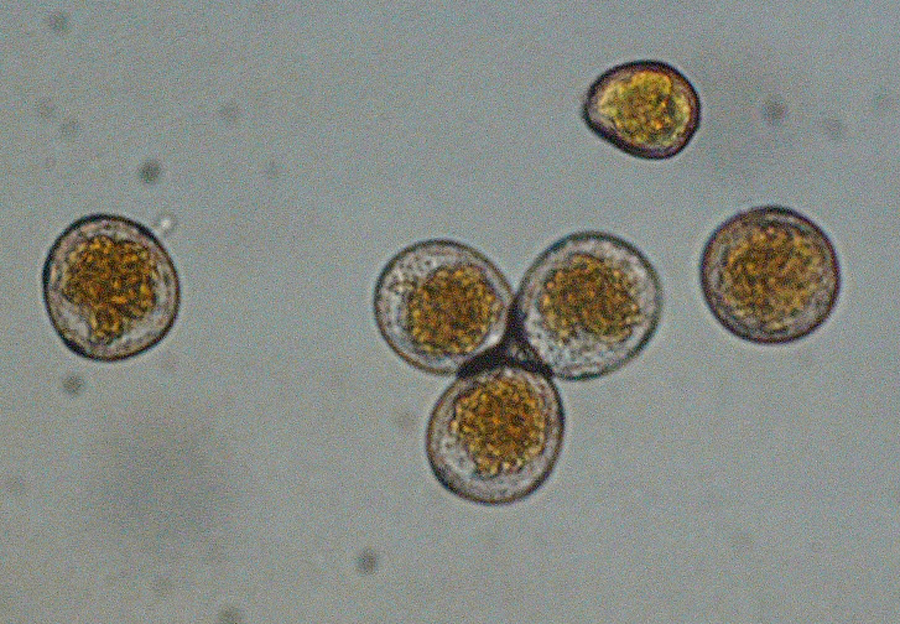 Figure 1b. Urediniospores of P. striiformis = 40x
Figure 1b. Urediniospores of P. striiformis = 40x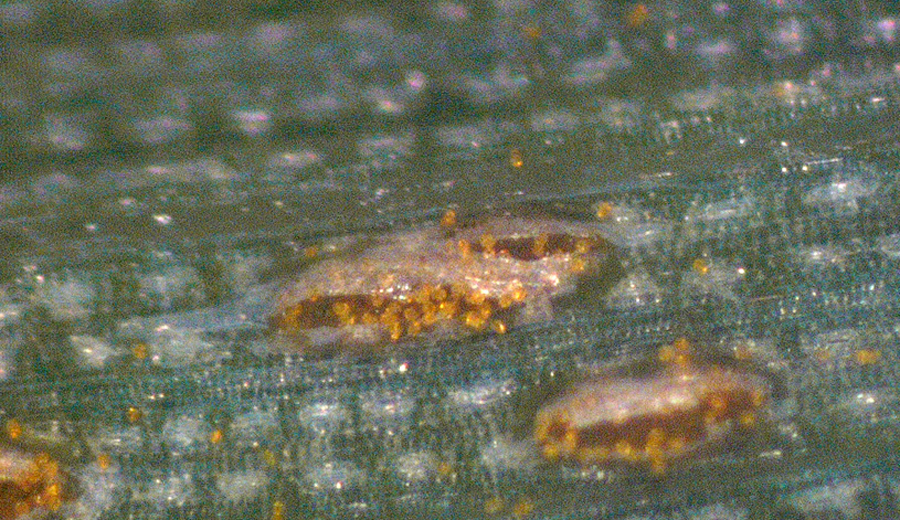 Figure 2. Pustules (sori) of P. striiformis on wheat leaves.
Figure 2. Pustules (sori) of P. striiformis on wheat leaves.
Symptoms
The first sign of stripe rust is the appearance of yellow streaks (pre-pustules), followed by small, bright yellow, elongated uredial pustules arranged in conspicuous rows on the leaves, leaf sheaths, glumes and awns (Figure 3). Mature pustules will break open and release yellow-orange masses of urediniospores. In some varieties, long, narrow yellow stripes will develop on leaves. The infected tissues may become brown and dry as the plant matures or becomes stressed (Figure 4). Severe early infection can result in plant stunting.
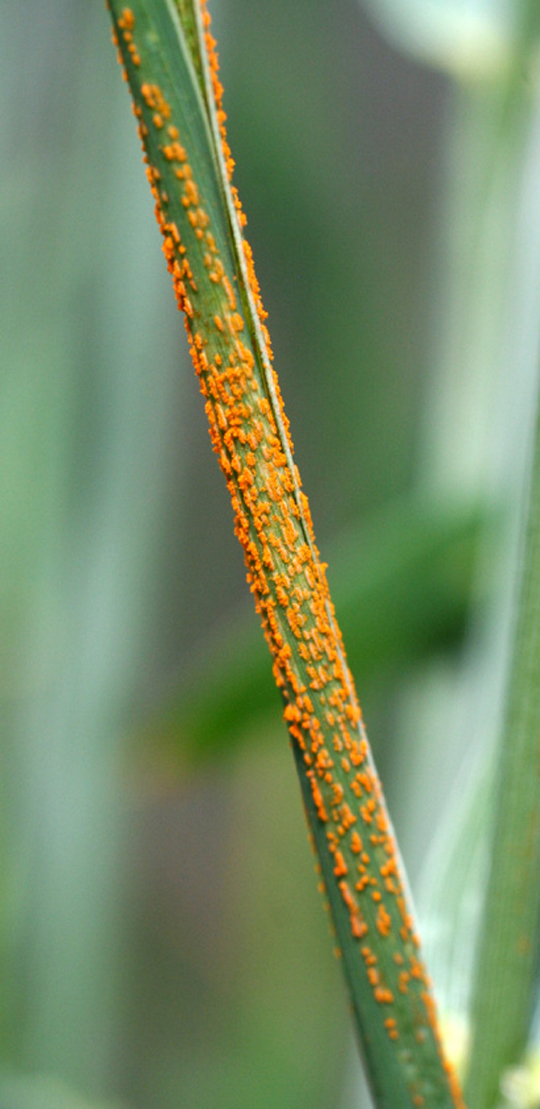 Figure 3a. Stripe rust symptoms.
Figure 3a. Stripe rust symptoms.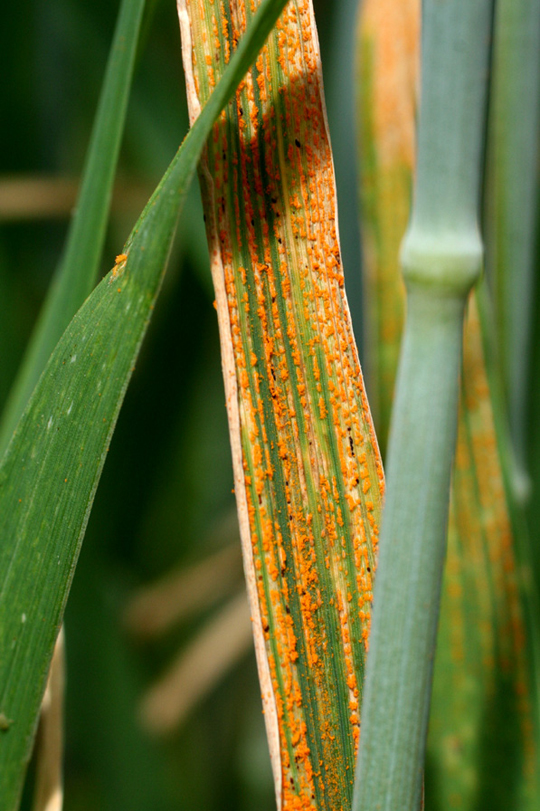 Figure 3b. Stripe rust symptoms.
Figure 3b. Stripe rust symptoms.
 Figure 3c. Stripe rust symptoms.
Figure 3c. Stripe rust symptoms.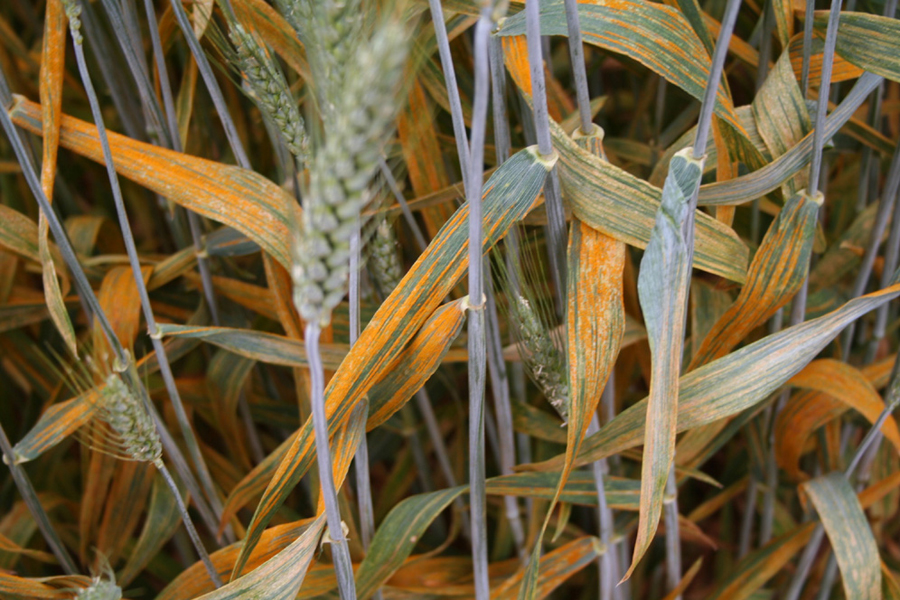 Figure 3d. Stripe rust symptoms.
Figure 3d. Stripe rust symptoms.
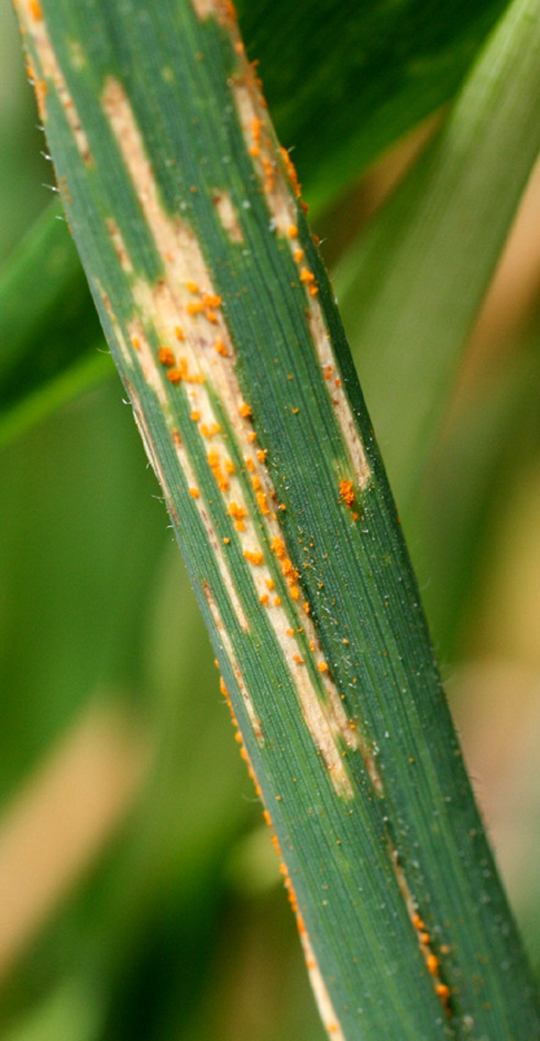 Figure 4a. Mature symptoms of stripe rust. Infected plant tissue becomes brown and dry.
Figure 4a. Mature symptoms of stripe rust. Infected plant tissue becomes brown and dry.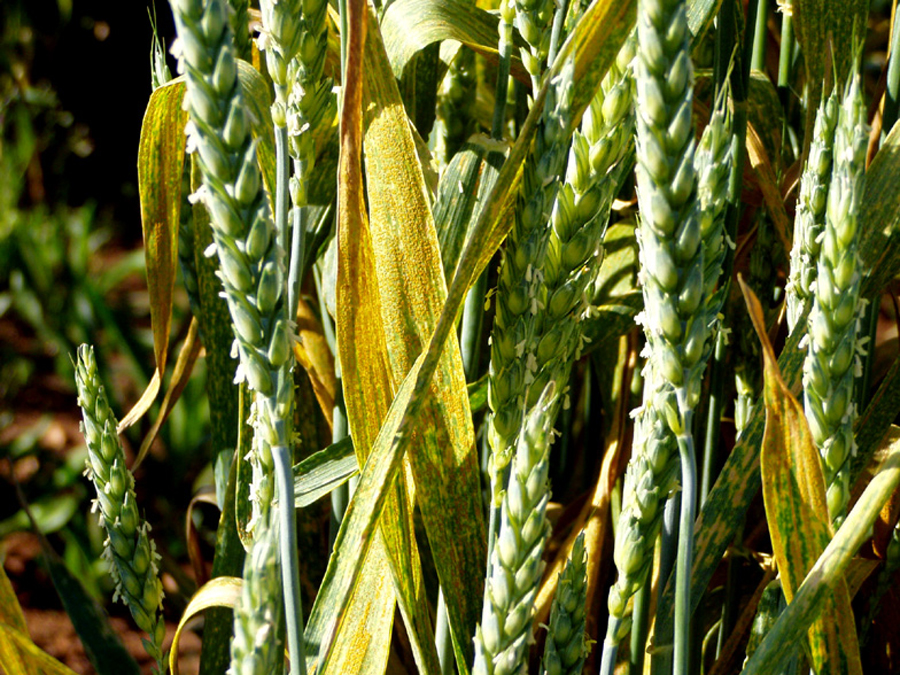 Figure 4b. Mature symptoms of stripe rust. Infected plant tissue becomes brown and dry.
Figure 4b. Mature symptoms of stripe rust. Infected plant tissue becomes brown and dry.
Conditions Favoring the Disease
Puccinia striiformis f. sp. tritici can survive as dormant mycelium on wheat. Urediniospores can perpetuate the disease on green host tissue, such as volunteer wheat or susceptible wheat growing in other fields. Stripe rust is most common in higher elevations and cooler climates. The pathogen is best sustained when nighttime temperatures are < 60 ºF (15 ºC). Stripe rust can develop on wheat at lower temperatures than other rusts. Optimum urediniospore germination occurs at 44–59 ºF (7–15 ºC). Infection and disease development is most rapid between 50–60 ºF (10–16 ºC). Urediniospores are spread via wind currents to healthy plants where they can initiate new infections. Heavy dew or intermittent rains can accelerate the spread of the disease. Infection tends to cease when temperatures consistently exceed 71–73 ºF (21–23 ºC). In Georgia, stripe rust on winter wheat is first observed in late winter or early spring (February to March).
Control
Field Monitoring
Become familiar with stripe rust symptoms and anticipate environmental conditions that are conducive for the disease. Check fields periodically and early in the season. Use a hand lens to look for symptoms on all parts of the plant and examine a number of plants throughout the field. Rub your fingers over the leaf blade and look for yellow powdery residues. Field symptoms may not be sufficient to identify the disease and a physical sample might be needed for identification. Information on how and where to submit a sample is located at http://plantpath.caes.uga.edu/extension/clinic.html or by calling your county Extension office.
Genetic Control
Use of resistant varieties is the best way to control wheat losses to stripe rust. Two types of genetic resistance to stripe rust are known: a) seedling resistance and b) adult plant resistance. Seedling resistance, which is controlled by a single gene, is highly effective and lasts throughout the wheat life cycle.
Puccinia striiformis f. sp. tritici is a highly variable pathogen and new pathotypes are continually being discovered. The development of wheat varieties resistant to stripe rust makes use of resistant genes termed Yr. There are more than 40 Yr genes designated so far.
Adult plant resistance develops as the plants mature. Expression can occur at different growth stages ranging from boot to early head emergence, depending on the variety.
Because new races of the fungus can develop, it is important to know the susceptibility of a given wheat variety (Figure 5). Table 1 summarizes stripe rust reactions and three-year yield averages of common wheat varieties planted in Georgia (see annual CAES Small Grains Performance Tests Research Report or the CAES Production Guide for a yearly description of varieties) .
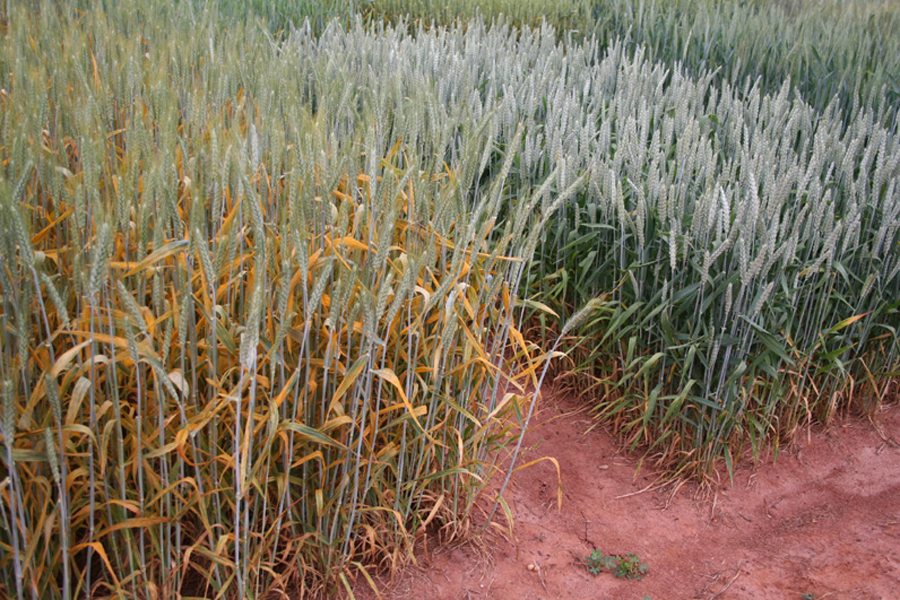 Figure 5a. Genetic resistance: a) Severely infected susceptible variety; b) Symptoms on leaves on a susceptible variety.
Figure 5a. Genetic resistance: a) Severely infected susceptible variety; b) Symptoms on leaves on a susceptible variety. Figure 5b. Genetic resistance: a) Non-infected resistant variety; b) Resistant variety.
Figure 5b. Genetic resistance: a) Non-infected resistant variety; b) Resistant variety.Chemical Control
In Georgia, several fungicides are currently labeled for stripe rust on wheat. Due to constant changes in fungicide labeling, check the entire product label and/or contact your local county Extension agent for the most up-to-date information. Guides for fungicide use can also be found in the annually-updated CAES Wheat Production Guide and the Georgia Pest Management Handbook (UGA Cooperative Extension Special Bulletin 28). Always follow product labels for recommendations, precautions and restrictions.
Cultural Control
Cultural measures can reduce the loss caused by stripe rust to some degree; however, wind dispersal of spores up to hundreds of miles can initiate seasonal epidemics of the disease. Weather systems that travel across northern Mexico and the southeastern U.S. could bring in rust spores and allow the disease to establish where environmental conditions are favorable for its development. Genetic resistance and constant monitoring when conditions are conducive for stripe rust are imperative for adequate stripe rust management.
| Table 1. Stripe rust resistance on selected Georgia wheat varieties. Adapted from the UGA CAES statewide variety testing program. | ||
| Variety | Stripe Rust Resistance |
Yield 3-yr average - Plains, GA Bu/acre |
| AGS 2000 | Poor | N/A |
| AGS 2031 | Good | 94.8 |
| AGS 2010 | Good | 89.0 |
| AGS 2060 | Good | 95.1 |
| AGS 2020 | Good | 102.9 |
| AGS 2026 | Good | 94.4 |
| Fleming | Good | 89.8 |
| McIntosh | Good | 87.2 |
| Panola | Good | 91.5 |
| Pioneer 26R61 | Good | 93.5 |
| SS8641 | Good | 98.6 |
| USG 3209 | Good | 97.6 |
| USG 3592 | Poor | 80.7 |
| Coker 9553 | Good | 93.3 |
Bibliography
Agrios, G. N. Plant Pathology. (3rd edition). 1988. Academic Press Inc. San Diego CA.
Bowden, R. L. 2006. Wheat Stripe Rust. Department of Plant Pathology. Kansas State University.
Chen, X., Moree, M., Milus, E. A., Long, D. L., Line, R. F., Marshall, D., and Jackson, L. 2000. Wheat Stripe Epidemics and Races of Puccinia striiformis f. sp. tritici in the United States in 2000. Plant Disease, 86: 39-46.
Line, R. F. 2002. Stripe Rust of Wheat and Barley in North America: A Retrospective Historical Review. Annu. Rev. Phytopathol. 40: 75-118.
Maloy, O. C. and Inglis D. A. Stripe Rust. 1993. Washington State University Bulletin SP0004.
Martinez-Espinoza, A. 2005. Georgia Plant Disease Loss Estimates.
Martinez-Espinoza, A. 2008. Disease Management in Wheat. 2008-2009 Wheat Production Guide.
Milus, E. A., Kristensen, K., Hovmoleer, M. S. 2009. Evidence for Increased Aggressiveness in a Recent Widespread Strain of Puccinia striiformis f. sp. tritici Causing Stripe Rust of Wheat. Phytopathology 99: 89-94.
Schumann, G.L. and K.J. Leonard. 2005. Stem Rust of Wheat (Black Rust). The Plant Health Instructor. DOI: 10.1094/PHI-I-2000-0721-01.
University of California. Integrated Pest Management for Small Grains. Division of Agriculture and Natural Resources Publication 3333.
Wellings, C., Edwards, J., and Thompson, R., 2007. Stripe Rust-An Update on the Yr17 Pathotype.
Wiese. M. V. 1998. Compendium of Wheat Diseases (2nd edition). APS Press St Paul MN.
Status and Revision History
Published on May 21, 2009
Published with Full Review on May 21, 2012
Published with Full Review on Mar 28, 2017
Published with Full Review on Jun 23, 2022


























































